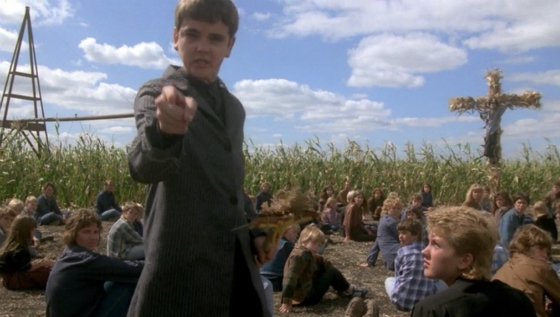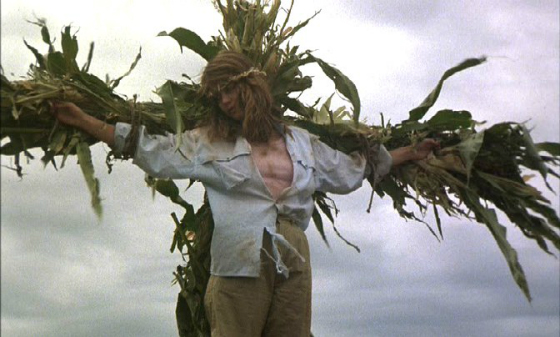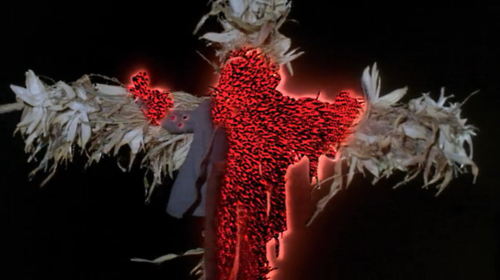TR Retro Review: Children of the Corn
 |
My wife is afraid of horror movies, but she’s very curious about them.
When I took her to Paranormal Activity 3, she wanted to leave halfway through. By the time it ended, she wanted to see it again. Taking her to the Nightmare on Elm Street remake was a huge mistake, though – not for the obvious reasons, but because they more explicitly made Freddy an icky rapist rather than just a killer (contrary to what some people remember, the original movies never explicitly said he was a child molester, just a child killer. That distinction makes a difference).
But for Halloween, she was wanting to watch something scary, with the provision that it not be too gory. Looking at what was on Netflix, we settled on Children of the Corn…because I’d never seen it before.
I had seen one of the sequels, back in college when I’d see a new movie every week no matter what and review it on the radio. The only thing I remember is that my friend Sean Bridgers was in it, and he had expressed disappointment that he was in a Stephen King movie without getting to kill anyone or be killed. Anyway, it’s one of those long past due things that it was about time I took a look at.
Part of the fun in watching a movie like this is seeing actors who you know today, but would not have at the time – Linda Hamilton and Peter Horton play the young couple lost on the back roads, and the young Hamilton looks the best she ever has. Horton, playing a character with the then-manly name of “Burt,” is a doctor, which of course proves helpful later, and Hamilton, for what might have been the last time in her career, is his girlfriend in peril.
What stands out immediately, and lingers in the memory longest, is Joao Fernandes’ cinematography – wide vistas of Nebraska cornfields dwarf our main characters and add to the sense of being completely lost in a same-y environment that never varies. When they hit the semi-abandoned town of Gatlin, same deal: the emptiness is palpable, and spooky, even when the threat turns out to be not much more than a bunch of dumbass kids.
Also to the good: Burt and Vicky aren’t morons. They get lost not because of stupidity, but because something is playing tricks on them, and the roads don’t lead where they should, herding them to Gatlin even as they consciously try to go in the opposite direction. As we know from the movie’s opening scene, Gatlin is a town where the children have murdered all the adults (the element of surprise worked in their favor) and become weird religious cultists, and naturally they want Burt and Vicky to be their next offerings to the deity known as He Who Walks Behind the Rows.
 |
There are some fun ideas at play: modern horror protagonists would probably just start shooting the kids, but Burt and Vicky’s desire not to harm them despite those feelings being in no way reciprocal is what keeps the jeopardy going. In a fair fight, OF COURSE Brimstone and Sarah Connor could take these li’l bastards out, but the fear of killing even one is equal to the fear of getting killed by one. And it’s a good call that we are never told exactly what He Who Walks Behind the Rows is – it remains a nebulous force, rendered with occasionally horrible animation (’80s horror movies that use cartoon “laser” effects, like this and Halloween III, just aren’t going to scare people like they used to) and decent fake storm-clouds.
 |
The movie’s biggest weakness is simply that it never lets you forget it’s based on a short story. There’s a whole lot of nothing happening, as Burt and Vicky hide and the children pursue. This could have been a Twilight Zone episode, and is reminiscent of more than one, while being nowhere near as effective. Showing the killings in the town upfront may be a good shock to get the audience to pay attention, but it ruins the potential mystery aspect – if we honestly didn’t know what might be found in Gatlin, the story would be creepier. Yeah, the title maybe gives it away, but it could have been a metaphor.Periodic voice-over narration from one of the few good kids is also a mistake. It doesn’t make sense, since not all the story is from their perspective, and it doesn’t tell you anything you wouldn’t know otherwise.
Yet the concept is strong enough to have stood the test of time and transcended the movie’s weaknesses – South Park in particular has recycled a lot of the imagery and riffed on the story. Perhaps because Lord of the Flies is too much of a downer and nobody reads books, Children of the Corn has become the super-heavyweight, pop-culture champ of “kids running their own world, to detrimental ends” by default. It’s extra-funny, by accident, when the survivors of the film are getting into their car to leave at the end, and the words “The End” appear onscreen, to reassure us that no last-minute jump scare is going to happen, and to show how blissfully unaware everyone was that seven sequels would follow. Just imagine if they’d signed Linda Hamilton to a multi-picture deal.
Given Children of the Corn‘s mainstay role in nerd canon, it’s odd that director Fritz Kiersch never again did anything nearly as notable. He has a way with images that would be more valuable with a stronger screenplay. I don’t hate on the movie – it’s a gorgeously shot piece that could use more plotting and menace. But by today’s standards, it’s not very scary, and my wife wasn’t bothered by it in the least.
A remake seems inevitable, and could even be better if handled correctly.
